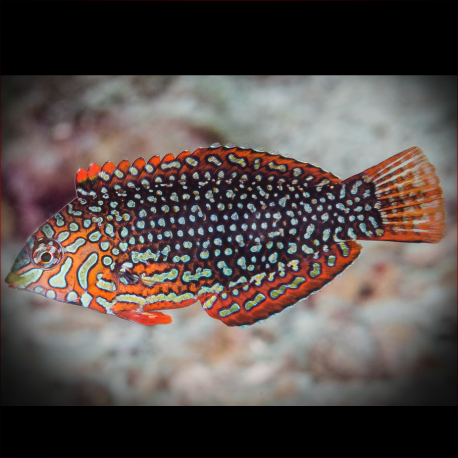More info
Datasheet
| Minimum Tank Size | 500 litres / 132.09 US gallons |
| Maximum Size | 13.0cm / 5.12inches |
| Reef Compatible | Always reef safe |
| Temperament | Docile |
| Temperature | 22.2°C / 71.96°F - 25.6°C / 78.08°F |
| Specific Gravity | 1.020-1.025 |
| Carbonate Hardness | 8-12 |
| pH | 8.1-8.4 |
General Description:
The False Leopard, also known as the Ornate Leopard Wrasse, belongs to the Labridae family. This species, scientifically known as Macropharyngodon ornatus, showcases mesmerizing colors and patterns, making it an attractive addition to aquariums. Indigenous to the Indo-Pacific region, its distribution spans from Sri Lanka to Australia, Indonesia, and New Guinea.
Aquarium Suitability:
Highly demanding in terms of its dietary needs, the False Leopard is not recommended for novice aquarists. It thrives best in well-established aquariums with ample natural food sources such as small snails and pods. Maintaining these fish can be challenging as they quickly exhaust their food supply, requiring regular supplementation with various frozen foods multiple times a day. They are better suited to tanks without food competitors, as scarcity can lead to malnutrition and eventual death. Additionally, transporting them without a sandy substrate may cause injuries around their mouth area.
Care and Hardiness:
With an average hardiness level, the False Leopard requires meticulous care and attention, especially during transportation and acclimatization to aquarium conditions. To ensure their well-being, it's crucial to provide a deep sandy substrate of at least 2 inches to facilitate their natural behavior of burrowing into the sand when threatened or sleeping.
Reef Suitability:
Always considered reef safe, the False Leopard Wrasse is a valuable addition to reef aquariums, contributing to the ecosystem's balance and serving as an efficient predator of unwanted invertebrates like flatworms and pyramid snails.
Aquarium Setup:
When preparing an aquarium for the False Leopard, aquarists should emphasize a sandy substrate, frequent feeding schedules, and a peaceful tank environment devoid of aggressive fish. Adequate space, hiding spots, and natural food sources are essential for their well-being.
Behaviour:
Docile and shy by nature, the False Leopard Wrasse displays unique behaviors such as burrowing into the sand when stressed or sleeping. It is advised to avoid keeping them with more aggressive tank mates to prevent feeding difficulties.
Feeding and Diet:
The recommended diet for the False Leopard includes small crustaceans like krill, mysis, and artemia, along with zooplankton such as Cyclops and pods. Their feeding regimen should comprise multiple daily feedings, especially if their natural food sources are limited within the aquarium.
Dimorphism:
This species is hermaphroditic, capable of changing gender from female to male as needed. Understanding this characteristic is vital for aquarists interested in potential captive reproduction within their aquarium.
Habitat and Distribution:
In their natural habitat, False Leopards inhabit regions across the East and West Indian Oceans, Australia, Japan, Indonesia, and New Zealand. Their vibrant colors and intricate patterns make them a sought-after species among marine enthusiasts.
Note:
Given their sensitive nature, it is crucial to approach the care of False Leopard Wrasses with experience, preparation, and extra caution to ensure their well-being and longevity in the aquarium environment.

